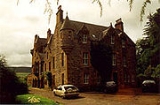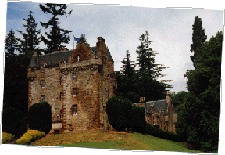
Castle Leod
Encyclopedia

Strathpeffer
Strathpeffer is a village and former spa town in Ross and Cromarty, Highland, Scotland, with a population of 1,469.-Geography:It lies in a glen 5 miles west of Dingwall, with varying elevation from 200 to 400 feet above sea level...
in the east of Ross-shire
Ross-shire
Ross-shire is an area in the Highland Council Area in Scotland. The name is now used as a geographic or cultural term, equivalent to Ross. Until 1889 the term denoted a county of Scotland, also known as the County of Ross...
in the Scottish Highlands
Scottish Highlands
The Highlands is an historic region of Scotland. The area is sometimes referred to as the "Scottish Highlands". It was culturally distinguishable from the Lowlands from the later Middle Ages into the modern period, when Lowland Scots replaced Scottish Gaelic throughout most of the Lowlands...
. It is currently the seat of the Chief of the Clan MacKenzie
Clan MacKenzie
Clan Mackenzie is a Highland Scottish clan, traditionally associated with Kintail and lands in Ross-shire.-Origins:The Mackenzies, a powerful clan of Celtic stock, were not among the clans that originated from Norman ancestry. Descendants of the long defunct royal Cenél Loairn of Dál Riata, they...
, although the lands belonged to the Chief of the Clan MacLeod of Lewis
Clan MacLeod of Lewis
Clan Macleod of The Lewes, commonly known as Clan MacLeod of Lewis, is a Highland Scottish clan, which at its height held extensive lands in the Western Isles and west coast of Scotland. From the 14th century up until the beginning of the 17th century there were two branches of Macleods: the...
until the 17th century. It is a category A listed building, and the grounds are listed in the Inventory of Gardens and Designed Landscapes of Scotland, the national listing of significant gardens.
Background
In the early seventeenth century the main chieftainship line of the Clan MacLeod of LewisClan MacLeod of Lewis
Clan Macleod of The Lewes, commonly known as Clan MacLeod of Lewis, is a Highland Scottish clan, which at its height held extensive lands in the Western Isles and west coast of Scotland. From the 14th century up until the beginning of the 17th century there were two branches of Macleods: the...
became extinct, and the chieftainship passed to the MacLeods of Raasay
Raasay
Raasay is an island between the Isle of Skye and the mainland of Scotland. It is separated from Skye by the Sound of Raasay and from Applecross by the Inner Sound. It is most famous for being the birthplace of the poet Sorley MacLean, an important figure in the Scottish literary renaissance...
. Later the Lewis MacLeod clansmen were forced to accept the ascendancy of their cousins at Dunvegan
Dunvegan Castle
Dunvegan Castle is a castle a mile and a half to the North of Dunvegan on the Isle of Skye, situated off the west coast of Scotland. It is the seat of the MacLeod of MacLeod, chief of the Clan MacLeod. Dunvegan Castle is the oldest continuously inhabited castle in Scotland and has been the...
and the two MacLeod clans became one. As a result the Barony of Lewis fell into the hands of the chief of the Clan MacKenzie. The last chief of the MacLeods of Lewis had married a daughter of the MacKenzie chief. The MacKenzie chief thereby claimed the barony of Lewis as his own. However, the MacLeod clansmen prospered under the chieftainship of the Clan MacLeod
Clan MacLeod
Clan MacLeod is a Highland Scottish clan associated with the Isle of Skye. There are two main branches of the clan: the Macleods of Harris and Dunvegan, whose chief is Macleod of Macleod, are known in Gaelic as Sìol Tormoid ; the Macleods of Lewis, whose chief is Macleod of The Lewes, are known in...
of Skye
Skye
Skye or the Isle of Skye is the largest and most northerly island in the Inner Hebrides of Scotland. The island's peninsulas radiate out from a mountainous centre dominated by the Cuillin hills...
.
The castle was granted to John of Killin, 10th Chief of Clan MacKenzie (1485-1561) after he fought at the Battle of Flodden. The castle was passed to his great-grandson Kenneth Mackenzie, 1st Lord Mackenzie of Kintail
Kenneth Mackenzie, 1st Lord Mackenzie of Kintail
Kenneth Mackenzie, the first Lord Mackenzie of Kintail , was a Highland clan chief who secured for himself and his heirs the entirety of the island of Lewis in the Outer Hebrides and successfully pursued a bloody feud with the Macdonells of Glengarry.-Origins:Mackenzie was the son of Colin Cam...
, who granted it in 1608 to his brother Sir Roderick "Rorie" Mackenzie. In 1605 Sir Roderick married Margaret MacLeod, heiress of Torquil MacLeod of Lewis, bringing her immense wealth into the family and also settling the feud between the MacLeods and the Mackenzies over the Barony of Coigach
Coigach
Coigach today refers to the peninsula "beyond the big rock" north of Ullapool, in Wester Ross in the Northwest Highlands of Scotland. Anciently till changes in civil registration districts in 1857 the Barony also included Isle Martin, the lands down to Corrie beyond Ullapool, the various farms of...
, which thus passed into the Mackenzie family.
Castle history
The castle is believed to have been built on the site of a very ancient Pictish fort from before the 12th century. The current castle is the result of work carried out in the early 17th century by Sir Roderick Mackenzie, the ancestor of the Earl of CromartieEarl of Cromartie
Earl of Cromartie is a title that has been created twice, both times for members of the Mackenzie family. This branch of the family descends from Sir Roderick Mackenzie, whose elder brother Kenneth Mackenzie was created Lord Mackenzie of Kintail in 1609 and was the father of Colin Mackenzie, 1st...
. The castle has remained the seat of the Earls of Cromartie ever since.
In 1746 George Mackenzie, 3rd Earl of Cromartie
George Mackenzie, 3rd Earl of Cromartie
George Mackenzie, 3rd Earl of Cromartie succeeded his father John, the 2nd earl, in February 1731. In 1745, he joined Charles Edward Stuart and he served with the Jacobites until April 1746 when he was taken prisoner in Sutherland after the Battle of Littleferry...
, forfeited the estate, following his support for the ill-fated 1745 Jacobite Uprising
Jacobite Rising of 1745
The Jacobite rising of 1745, often referred to as "The 'Forty-Five," was the attempt by Charles Edward Stuart to regain the British throne for the exiled House of Stuart. The rising occurred during the War of the Austrian Succession when most of the British Army was on the European continent...
. The estates, but not the title, were restored to his son in 1784. The castle was reported to already be in a run-down state earlier in the same century, when the estate was badly debt-ridden. By 1814 it was described as "Quite a ruin... deserted except by crows", though this may have applied more to the upper upper floors.
In the mid 19th century, Castle Leod was completely renovated by the Hay-Mackenzies. Descendents of the 3rd Earl, the Hay-Mackenzies were restored to the earldom of Cromartie when Anne Hay-Mackenzie
Anne Sutherland-Leveson-Gower, Duchess of Sutherland
Anne Sutherland-Leveson-Gower, Duchess of Sutherland , 1st Countess of Cromartie in her own right and known as the Marchioness of Stafford from 1849 to 1861, was a British peeress....
married George Sutherland-Leveson-Gower, 3rd Duke of Sutherland
George Sutherland-Leveson-Gower, 3rd Duke of Sutherland
George Granville William Sutherland Leveson-Gower, 3rd Duke of Sutherland , styled Viscount Trentham until 1833, Earl Gower in 1833 and Marquess of Stafford between 1833 and 1861, was a British politician.-Background:Sutherland was the son of George Sutherland-Leveson-Gower, 2nd Duke of Sutherland...
in 1861. In 1851 large extensions were added to the north of the castle, which were rebuilt in 1904. The roof was made watertight as recently as 1992. The castle remains the home of the Earl of Cromartie, and is open to the public on a limited number of days.
The castle

Tower house
A tower house is a particular type of stone structure, built for defensive purposes as well as habitation.-History:Tower houses began to appear in the Middle Ages, especially in mountain or limited access areas, in order to command and defend strategic points with reduced forces...
, built of red sandstone, forms the earliest part of the castle, and may be based on a 15th-century building. An additional section was later added in the re-entrant angle, making the castle square in plan, and accommodating a larger staircase and extra bedrooms. The date 1616 is carved on a dormer
Dormer
A dormer is a structural element of a building that protrudes from the plane of a sloping roof surface. Dormers are used, either in original construction or as later additions, to create usable space in the roof of a building by adding headroom and usually also by enabling addition of windows.Often...
window, but it is not known if this date refers to the original phase or the extension. The addition was built over the parapet
Parapet
A parapet is a wall-like barrier at the edge of a roof, terrace, balcony or other structure. Where extending above a roof, it may simply be the portion of an exterior wall that continues above the line of the roof surface, or may be a continuation of a vertical feature beneath the roof such as a...
of the original front, and is more decorative in style.
In some parts the walls of the castle are 6 to 8 ft (1.8 to 2.4 ) thick. Other defensive measures include the iron grilles which remain on some lower windows, and numerous splayed gun loops and arrow-slit windows. The rooms, some wood-panelled, are decorated with many Mackenzie portraits from past centuries, as well as antique furnishings and large-scale antique maps. Many original fittings are to be found around the castle. The grounds include two Spanish chestnuts, said to have been planted by John of Killin in 1556, to mark the confirmation of his acquisition of Castle Leod by Mary Queen of Scots.
See also
- Castles in ScotlandCastles in ScotlandThis list of castles in Scotland is a link page for any castle in Scotland.A castle is a type of fortified structure built during the Middle Ages. Scholars debate the scope of the word castle, but usually consider it to be the private fortified residence of a lord or noble...
- Clan MacKenzieClan MacKenzieClan Mackenzie is a Highland Scottish clan, traditionally associated with Kintail and lands in Ross-shire.-Origins:The Mackenzies, a powerful clan of Celtic stock, were not among the clans that originated from Norman ancestry. Descendants of the long defunct royal Cenél Loairn of Dál Riata, they...
- StrathpefferStrathpefferStrathpeffer is a village and former spa town in Ross and Cromarty, Highland, Scotland, with a population of 1,469.-Geography:It lies in a glen 5 miles west of Dingwall, with varying elevation from 200 to 400 feet above sea level...
- Clan MacLeod of LewisClan MacLeod of LewisClan Macleod of The Lewes, commonly known as Clan MacLeod of Lewis, is a Highland Scottish clan, which at its height held extensive lands in the Western Isles and west coast of Scotland. From the 14th century up until the beginning of the 17th century there were two branches of Macleods: the...

